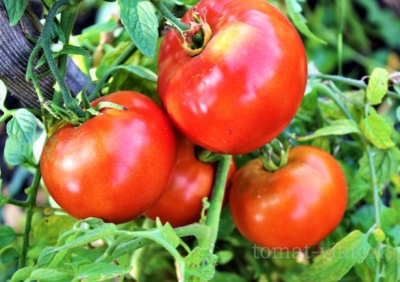
- Authors: Gavrish S.F., Morev V.V., Amcheslavskaya E.V., Degovtsova T.V., Volok O.A., Artemyeva G.M., Redichkina T.A. (LLC "Gavrish Breeding Firm")
- Year of approval: 2015
- Category: grade
- Growth type: determinant
- Appointment: fresh consumption, for pickling and preserving
- Ripening period: mid-early
- Ripening time, days: 85-95
- Growing conditions: for open ground, for film greenhouses
- Bush size: undersized
- Bush height, cm: up to 80
For summer residents and gardeners who like to remove early tomatoes from the garden, the Red Rooster variety will be a godsend. The plant, which grows well both in the open field and in the greenhouse, pleases with high yields, without requiring complex agricultural technology in return.
Breeding history
This mid-early type of tomato is the creation of a group of Russian breeders (Gavrish, Amcheslavskaya, Degovtsova, Morev) representing the Gavrish agricultural firm. The nightshade crop was bred in 2013. The variety was entered in the State Register of the Russian Federation and approved for use in 2015. Recommended regions for growing Red Rooster tomatoes are all climatic zones of the country.
Description of the variety
Plant Red Rooster is a low-growing determinant bush that grows up to 70-80 cm. It is characterized by compactness, strong central shoot, high thickening of large green leaves, powerful root system and simple type of inflorescence.
On the recommendation of specialists, the plant requires the formation of 2-3 stems, partial pinching and a mandatory garter to the support, otherwise the stems will deform or break under the weight of weighty berries. The bushes do not need to pinch the tops, since their growth stops on their own.
The main qualities of the fruit
Tomato Red Rooster belongs to the group of large-fruited tomatoes. On average, he gains weight 160-180 grams. The color of the fruit is uniform, bright red, and the shape is flat-round with light ribbing. In an unripe form, tomatoes are light green in color with darkening at the base.
The peel of tomatoes is thin, with a pronounced gloss on the surface, but elastic and strong, which prevents the appearance of cracks on the fruits, and also preserves them during transportation and long-term storage.
Taste characteristics
This type of nightshade is characterized by a pleasant taste and aroma. In the taste, sweetness and sourness are optimally balanced, which gives a slight piquancy to the vegetable. Tomato pulp is moderately firm, fleshy, juicy, with few seeds.
The variety for its intended purpose is universal, so tomatoes are good for eating fresh, canned, in a processed form (sauces, dressings, mashed potatoes).
Ripening and fruiting
Culture The Red Rooster is a representative of the mid-early varieties. From full germination of seeds to the appearance of the first ripe tomatoes, 85-95 days pass. The fruits ripen evenly and amicably, so they can be removed with whole brushes. The fruiting phase is not extended (July-August), so the tomatoes have time to reach full maturity before the first cold snaps. Ripe berries do not crumble.
Yield
The variety is endowed with a significant yield. Observing the basic rules of agricultural technology, from 1 m2 you can collect from 4 to 6 kg of tomatoes.
The timing of planting seedlings and planting in the ground
The plant is grown in seedlings. Sowing seeds for seedlings is performed 55-60 days before transplanting to a garden bed or greenhouse. Most often this occurs at the end of March - beginning of April. It is recommended to pre-sort the seed material and disinfect it using a weak solution of potassium permanganate.
Seed germination can be accelerated through the greenhouse effect (polyethylene or glass). At the stage of the appearance of 2 leaves, the bushes are dived (seated in separate containers). Shrubs should grow in a warm and lighted room. A few weeks before transplanting, it is recommended to harden the seedlings daily, exposing them to fresh air.
Planting on a bed of bushes is carried out with warm soil and an average daily temperature of + 14-16 ° C. The best time is the end of May.

Growing tomato seedlings is an extremely important process, because it largely depends on whether the gardener will be able to harvest at all. All aspects must be taken into account, from seedbed preparation to planting in the ground.
Landing scheme
For the healthy development of the culture and the convenience of caring for it, it is required to observe the planting density - 3-4 bushes per 1 m2. The optimal planting scheme is considered to be 40x50 cm.

Growing and care
The culture should be grown in loose, moist, fertilized and cleaned soil. It is desirable that the site is well lit by the sun's rays and protected from strong winds.
Plant care consists of regular watering, feeding, loosening the soil, forming and tying bushes, removing stepchildren, preventing viruses and pest infestations.




A plant needs different micronutrients at each stage of growth. All fertilizers can be divided into two groups: mineral and organic. Folk remedies are often used: iodine, yeast, bird droppings, eggshells.
It is important to observe the rate and period of feeding. This also applies to folk remedies and organic fertilizers.
Disease and pest resistance
The variety has high immunity to many tomato diseases, however, preventive spraying is recommended. Treatments with preparations containing copper, which prevent late blight, will be especially useful.


Resistant to adverse weather conditions
Red Rooster tomatoes withstand sharp weather fluctuations, including temperature drops, prolonged drought, prolonged heat. They are frost-resistant.
Growing regions
Due to its resistance to stress and the ability to quickly adapt to the climatic characteristics of the growing zone, this type of tomato can be grown in any region. In the central and southern lane in open ground, and in the northern ones - in a greenhouse.
Review overview
Despite its "youth", the variety is in demand among gardeners and farmers, since it is simple in agricultural technology, resistant to viruses, endowed with excellent taste, good presentation, and also easily tolerates transportation and long-term storage.

























































































